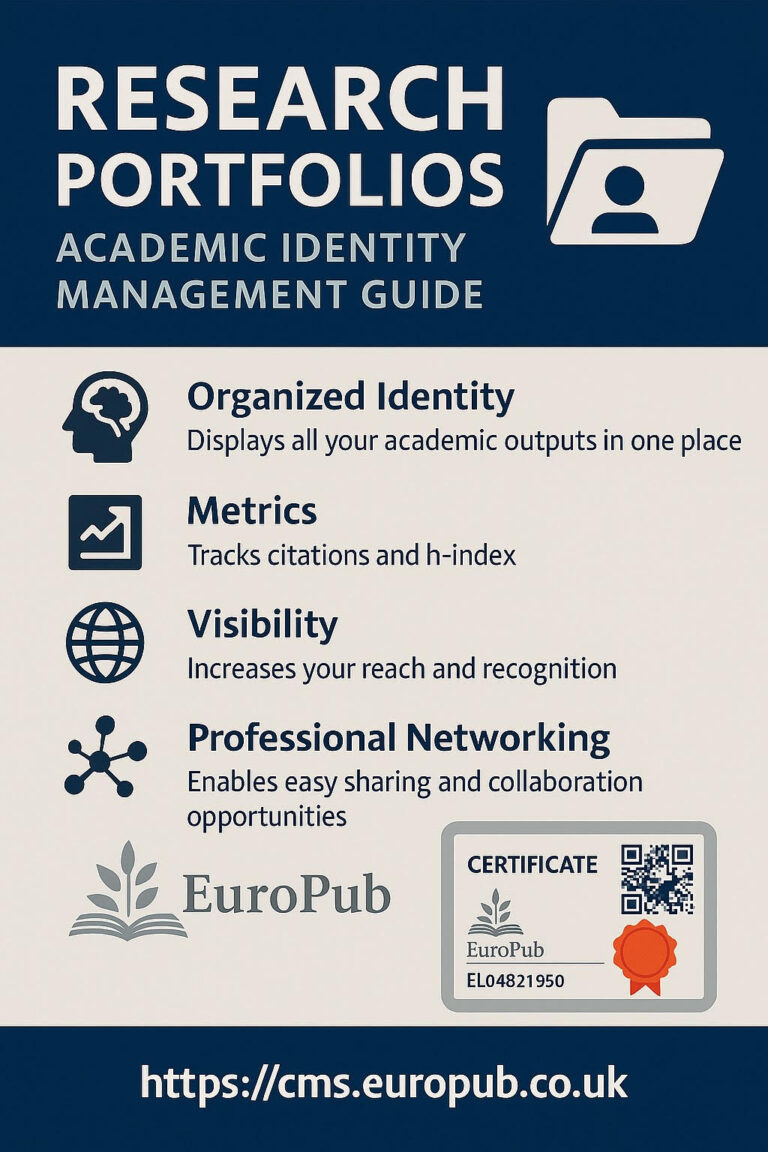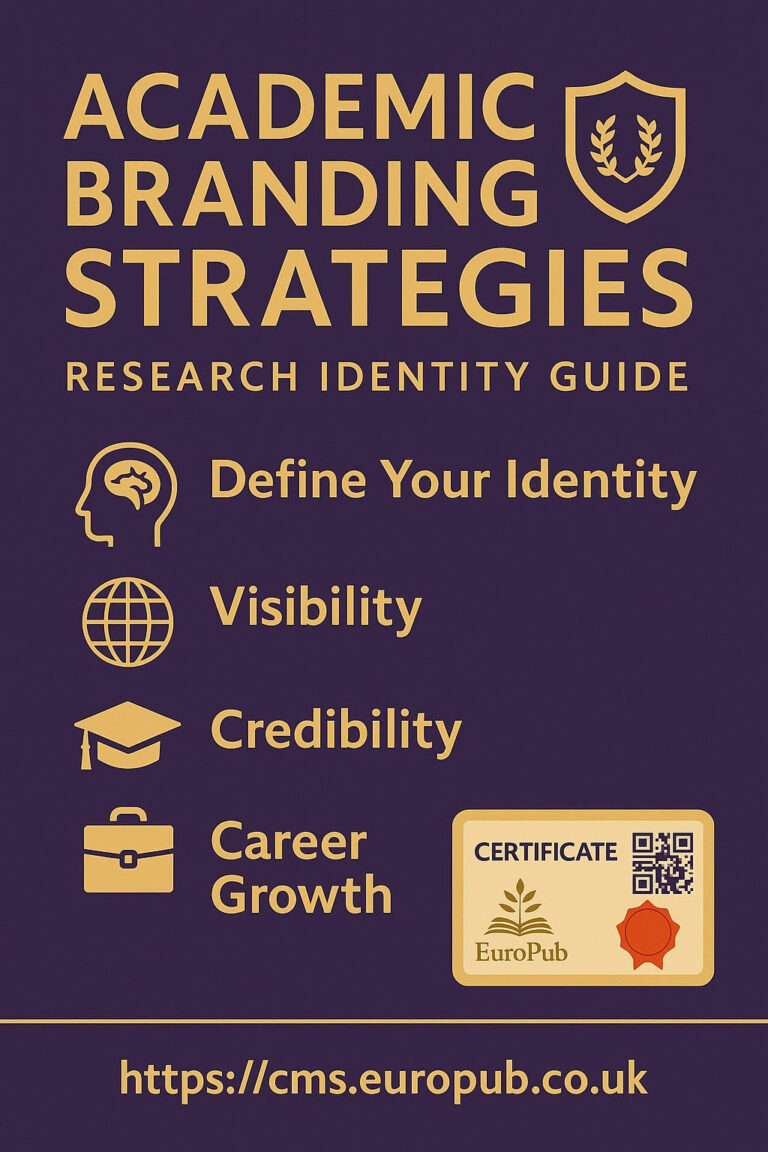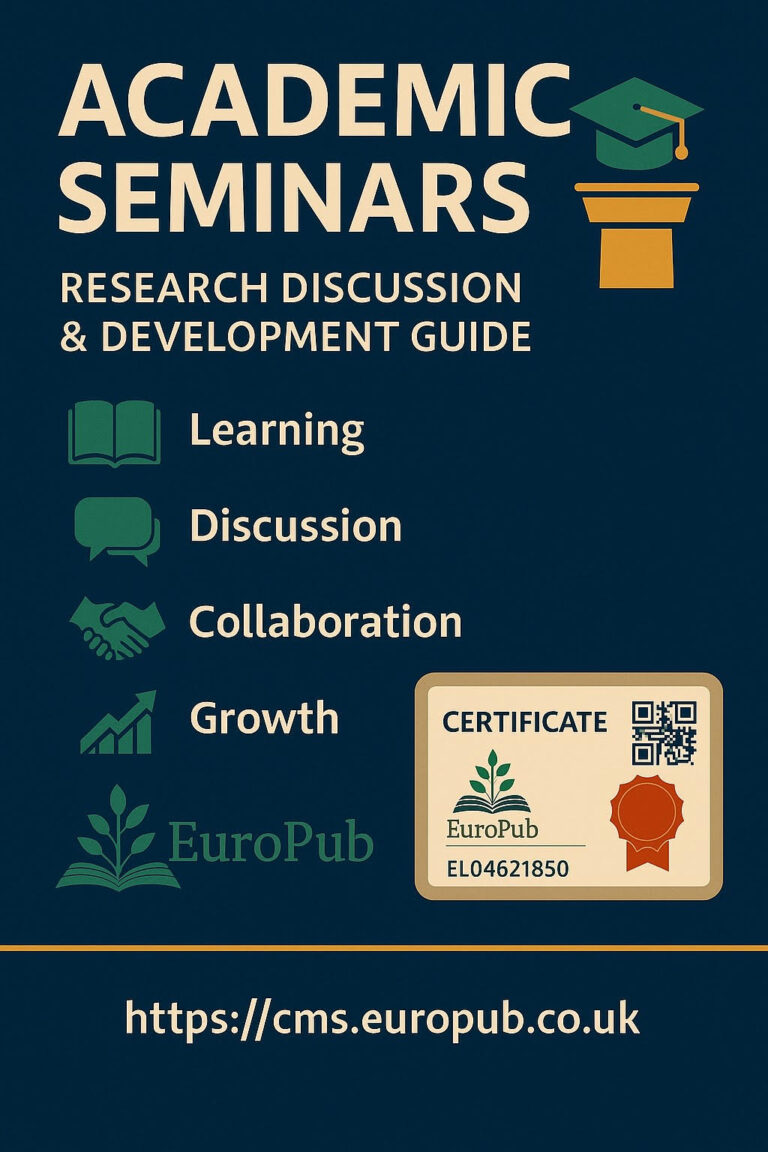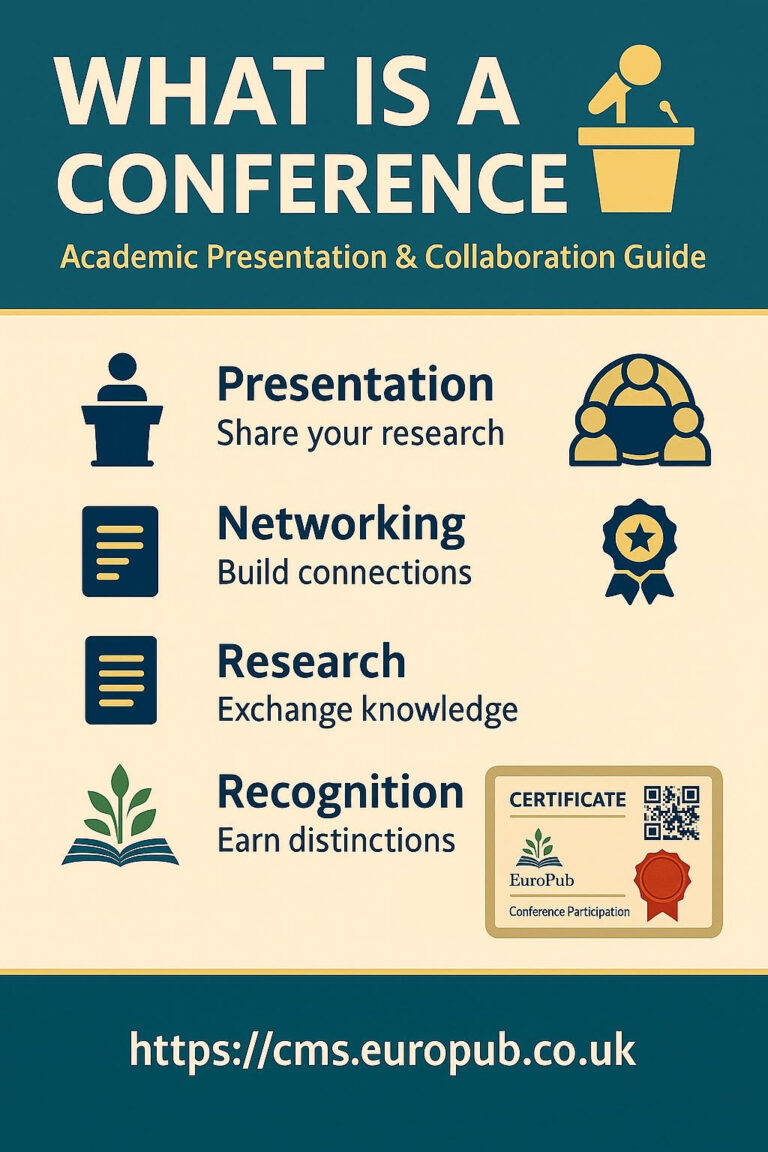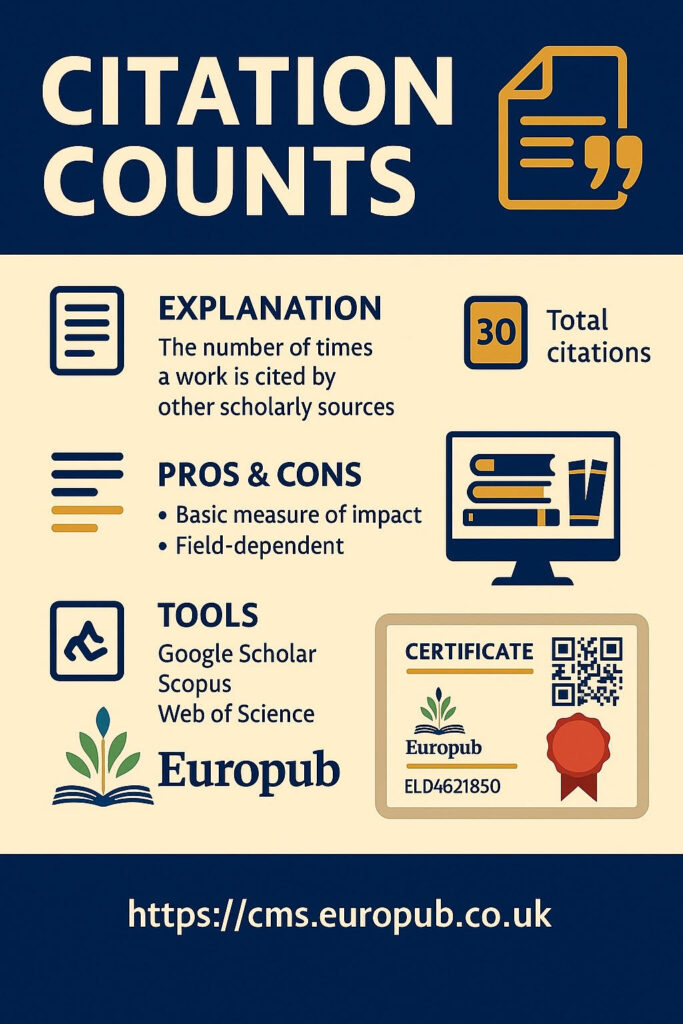
 What Are Citation Counts?
What Are Citation Counts?
Citation counts represent the number of times a published work has been cited by other scholarly sources (articles, books, conference papers, etc.).
They serve as the basic building block for almost every academic metric — from the Impact Factor and h-index to the i10-index and Altmetrics.
A citation acts as a formal acknowledgment that a work has contributed to another researcher’s study.
 Example:
Example:
If your paper has been cited by 30 other works, your citation count = 30.
 How Citation Counts Are Calculated
How Citation Counts Are Calculated
Each database tracks citations differently.
Here’s how the major platforms count them:
| Database | Citation Tracking Source | Coverage | Accuracy |
|---|---|---|---|
| Google Scholar | Academic & non-academic PDFs | Broad | May include duplicates |
| Scopus | Peer-reviewed journals & conferences | Moderate | Verified |
| Web of Science (WoS) | Indexed academic journals only | Narrow | Very accurate |
| CrossRef | DOI-based reference matching | Varies | DOI-dependent |
| Dimensions / Lens.org | Open-access + CrossRef data | Broad | Transparent |
 Why Citation Counts Matter
Why Citation Counts Matter
Citation counts are the core measure of research visibility and influence.
They help assess how widely your work has been read, referenced, and built upon.
Key uses:
- Evaluate researcher or journal impact
- Measure institutional or national research productivity
- Guide funding, promotions, and awards
- Identify trending topics and collaborations
 Types of Citations
Types of Citations
- Self-citations — You cite your own previous works.
- Independent citations — Cited by other researchers.
- Collaborative citations — Papers citing work by co-authors.
- Negative citations — Referenced as criticism or contradiction.
- Cross-disciplinary citations — From fields outside your specialty.
 Interpreting Citation Counts Correctly
Interpreting Citation Counts Correctly
Citation counts do not always equal quality. They depend on:
- Field size and citation culture
- Time since publication
- Type of paper (review papers often gain more citations)
- Journal visibility and indexing
 Tip: Compare citation counts within your field, not across disciplines.
Tip: Compare citation counts within your field, not across disciplines.
 Tools to Track Citation Counts
Tools to Track Citation Counts
| Tool | Features | Free/Paid |
|---|---|---|
| Google Scholar Citations | Automatic tracking, h-index, i10-index |  Free Free |
| Scopus Author Profile | Verified peer-reviewed citations |  Paid (institutional) Paid (institutional) |
| Web of Science ResearcherID | Journal-level validation |  Paid Paid |
| CrossRef Event Data | DOI-based open data |  Free Free |
| Europub Citation Dashboard | Certificate verification + EuroCode system |  Free for registered authors Free for registered authors |
 How to Improve Your Citation Counts Ethically
How to Improve Your Citation Counts Ethically
 Publish in indexed journals (Scopus, WoS, DOAJ)
Publish in indexed journals (Scopus, WoS, DOAJ)
 Share preprints on repositories (e.g., ResearchGate, arXiv)
Share preprints on repositories (e.g., ResearchGate, arXiv)
 Present at conferences and workshops
Present at conferences and workshops
 Write review articles summarizing key areas
Write review articles summarizing key areas
 Use consistent author names and ORCID ID
Use consistent author names and ORCID ID
 Ensure high-quality references and keywords
Ensure high-quality references and keywords
 Common Misconceptions
Common Misconceptions
 “More citations always mean better research.”
“More citations always mean better research.”
– Not necessarily. Citation context and quality matter more.
 “Self-citations are unethical.”
“Self-citations are unethical.”
– Not always — if relevant and limited, they’re acceptable.
 “Older papers always have more citations.”
“Older papers always have more citations.”
– True generally, but new impactful papers can surpass older ones quickly.
 “All databases show the same number.”
“All databases show the same number.”
– Citation counts vary by platform coverage and indexing rules.
 Ethical Guidelines
Ethical Guidelines
- Avoid citation manipulation or citation rings.
- Do not request mutual citations with colleagues.
- Report self-citation rates transparently.
- Follow COPE and DORA principles for fair assessment.
 FAQs (Frequently Asked Questions)
FAQs (Frequently Asked Questions)
Q1. What counts as a citation?
 A formal reference to your work in another publication.
A formal reference to your work in another publication.
Q2. Who tracks citation counts?
 Major indexing databases (Google Scholar, Scopus, WoS, CrossRef, Europub).
Major indexing databases (Google Scholar, Scopus, WoS, CrossRef, Europub).
Q3. Why do citation numbers differ across databases?
 Each uses different coverage and criteria for inclusion.
Each uses different coverage and criteria for inclusion.
Q4. Can I see who cited me?
 Yes, Google Scholar and Scopus show the list of citing papers.
Yes, Google Scholar and Scopus show the list of citing papers.
Q5. How often are citation counts updated?
 Google Scholar updates weekly; Scopus and WoS update monthly.
Google Scholar updates weekly; Scopus and WoS update monthly.
Q6. What are “unique citations”?
 Citations excluding duplicates, self-citations, or conference abstracts.
Citations excluding duplicates, self-citations, or conference abstracts.
Q7. Can citation counts decrease?
 Rarely — only when a paper is retracted or indexing errors are corrected.
Rarely — only when a paper is retracted or indexing errors are corrected.
Q8. Are citations from theses or books included?
 Yes, in Google Scholar; not always in Scopus or WoS.
Yes, in Google Scholar; not always in Scopus or WoS.
Q9. How do retractions affect citation counts?
 Retracted papers usually stop gaining valid citations.
Retracted papers usually stop gaining valid citations.
Q10. How can Europub help with citation tracking?
 Europub integrates verified DOIs and citation counts into researcher certificates and dashboards.
Europub integrates verified DOIs and citation counts into researcher certificates and dashboards.
Q11. How does citation count relate to impact factor?
 Impact Factor = average citations per paper for a journal (not for individuals).
Impact Factor = average citations per paper for a journal (not for individuals).
Q12. What is a “citation burst”?
 A sudden spike in citations, often when a topic becomes trending.
A sudden spike in citations, often when a topic becomes trending.
Q13. What is a good citation count?
 It depends on your field — 100 citations may be huge in humanities, average in medicine.
It depends on your field — 100 citations may be huge in humanities, average in medicine.
Q14. Can I remove unwanted citations?
 Only Google Scholar can remove invalid or duplicate citations upon request.
Only Google Scholar can remove invalid or duplicate citations upon request.
Q15. Are negative citations counted?
 Yes, even when critical — they still indicate influence.
Yes, even when critical — they still indicate influence.
Q16. What’s a self-citation limit?
 Generally under 20% of total citations is acceptable.
Generally under 20% of total citations is acceptable.
Q17. Does ORCID display citations?
 Not directly — it connects to citation databases like CrossRef or Scopus.
Not directly — it connects to citation databases like CrossRef or Scopus.
Q18. How do AI-generated papers affect citations?
 AI tools cannot be cited as authors; always cite original research sources.
AI tools cannot be cited as authors; always cite original research sources.
 Useful Resources
Useful Resources
- Google Scholar Citations
- Scopus Preview
- Web of Science ResearcherID
- CrossRef DOI Search
- Europub Certificate Management System
 Summary
Summary
| Category | Details |
|---|---|
| Metric | Citation Count |
| Measures | Number of citations received |
| Used By | Researchers, journals, institutions |
| Main Databases | Google Scholar, Scopus, WoS, CrossRef |
| Improvement Tips | Publish ethically, share widely, maintain visibility |
| Related Metrics | H-index, i10-index, Impact Factor |
